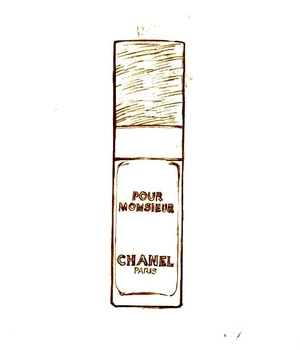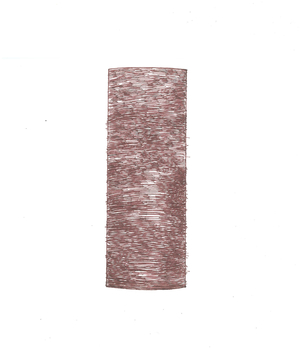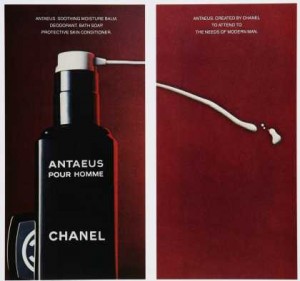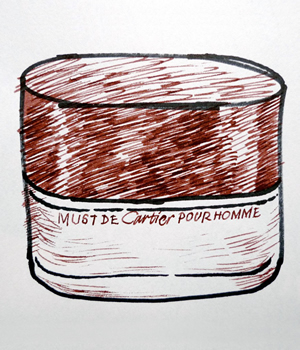Tagged With ‘Pour Monsieur’
Chanel
Pour Monsieur
7 July, 2015
 I’ve loved Pour Monsieur for decades now, so it was a bit of a surprise when I realised that I hadn’t reviewed it up till now. But actually I think that tells you something about the fragrance itself, which is so discreet that it’s all too easy to overlook – and that’s a real shame, because it’s a wonderful thing.
I’ve loved Pour Monsieur for decades now, so it was a bit of a surprise when I realised that I hadn’t reviewed it up till now. But actually I think that tells you something about the fragrance itself, which is so discreet that it’s all too easy to overlook – and that’s a real shame, because it’s a wonderful thing.
Pour Monsieur smells softly spicy when you first spray it on, but soon you also start smelling its mossy, herbaceous base. The spiciness comes partly from cardamom, and the woodiness is a mixture of oakmoss (actually a type of fragrant lichen) with tiny amounts of cedarwood, resinous labdanum (a kind of cistus) and earthy vetiver.
Chanel’s first modern men’s fragrance, it was conjured up by the perfumer Henri Robert and launched in 1955. Robert, who was born in 1899 and died in 1987, took over at Chanel after the retirement of the legendary Ernest Beaux, and went on to launch Chanel No19 in 1970 and Cristalle in 1974.
Pour Monsieur is one of the best examples of the perfume style or ‘family’ known as chypre, which derives from the French for Cyprus (the island rather than the tree), presumably inspired by the scent of Mediterranean herbs and shrubs baking in the sun. The basic combination – first popularised by François Coty in a 1917 perfume of the same name – combines bergamot, oakmoss and labdanum.
There have been endless variations on the theme since, but few of them match Pour Monsieur for sheer class; even its packaging is beautifully cool. Though it’s not an expensive perfume, it is redolent of luxury in its quiet complexity, like the deceptively simple face of a Patek Philippe watch. This is insider luxury, if you like, which is all about discretion and restraint rather than ostentation and excess.
The upside – in a perfume or a Patek Philippe – is that not everyone will recognise what you’re wearing. And while Pour Monsieur lasts a long time on the skin, it’s one of those fragrances that doesn’t carry far, so if you’re looking to impress it probably isn’t for you. But if wearing something wonderful makes you feel more self-confident and assured, then I can think of few better perfumes to buy.
Chanel
Antaeus
8 December, 2014
 When I first started thinking about The Sniff Box, I wondered how I could make it look different from other perfume blogs. I knew I’d have no problem with the overall look, thanks to my super-talented friend, Leanda Ryan, whose design perfectly reflects the idea of ‘perfume in plain English’.
When I first started thinking about The Sniff Box, I wondered how I could make it look different from other perfume blogs. I knew I’d have no problem with the overall look, thanks to my super-talented friend, Leanda Ryan, whose design perfectly reflects the idea of ‘perfume in plain English’.
But illustrating individual perfumes is a problem, as you’ll gather if you look at other perfume sites on the interweb. The obvious thing to do is to use a ‘pack shot’, generally supplied by the brand in question: it’s what the brands like as that’s how they want you to see their scent, but how many times do you want to see the same cheesy photograph?
The trouble is, if you don’t use a photo of the bottle, what can you use instead? How do you illustrate something you can smell but can’t actually see? It’s interesting to check out what other people come up with, but given that few bloggers can afford to commission photography or illustration, they’re generally stuck with stock shots of things like perfume ingredients – a sprig of lavender, say, or a twist of lemon – which are as cheesy as the pack shots they’re trying to avoid.
It took a while, but finally it struck me: since I can draw, after a fashion, why not draw my own illustrations? And that’s how I began.
All of which is a roundabout way of saying that, when I was trying to draw my bottle of Antaeus this morning, it gradually dawned on me that it is one of the most beautiful perfume bottles I know. It’s also one of the simplest: a tall, square, black-glass container that, if you took away the classy sans-serif Chanel lettering, would bear a more-than-passing resemblance to sinister monolith in 2001: A Space Odyssey.
Designed (or at least commissioned) by Chanel’s long-standing artistic director, Jacques Helleu, and launched in 1981, Antaeus was a kind of dark-side twin to the brand’s only other men’s fragrance at that time, Pour Monsieur (launched way back in 1955). Their bottles may be almost identical in shape, but Pour Monsieur is as cool and transparent as Antaeus is brooding and mysterious, and that reflects the fact that they’re very different scents.
Pour Monsieur is a refined, impeccably discreet fragrance: perfect in its way but perhaps (dare one whisper it?) just a tiny bit dull. Antaeus, by contrast, is a dark sexy scent that was launched just as the disco era crashed and burned: the same year Ian Schrager and Steve Rubell sold out of Studio 54 and the big disease with a little name first reared its ugly head.
Antaeus (the scent) was created by Chanel’s much-fêted in-house perfumer, Jacques Polge, in collaboration with François Damachy, now head of fragrance at Dior). As suggestive as Pour Monsieur is safe, its sexiness comes from castoreum, derived from a secretion extracted from beaver wee (I kid you not), which despite its revolting origins becomes, after careful treatment, a potent perfume ingredient, with its musky, leathery smell.
It’s a warm, slightly spicy leather scent, with a lot of Mediterranean herbs, most notably clary sage and thyme, that most of us would probably associate with hot, rocky mountainsides in southern France and Greece. My nose isn’t yet sensitive enough to identify them, but it also apparently contains labdanum (derived from two different species of Cistus, another Mediterranean shrub), as well as sandalwood and patchouli, which presumably add to the slightly hippyish warmth of the scent.
 Antaeus became a big best-seller in the early 1980s initially, it seems, among gay men, and with its hints of sex and leather it’s easy to see why. Chanel itself tapped into this trend in 1983 with a delightfully pervy advert (pictured), whose subtext I can leave to your imagination.
Antaeus became a big best-seller in the early 1980s initially, it seems, among gay men, and with its hints of sex and leather it’s easy to see why. Chanel itself tapped into this trend in 1983 with a delightfully pervy advert (pictured), whose subtext I can leave to your imagination.
But gay men, as we’ve often been told, are classic early adopters, and these days Antaeus is just as likely to attract anyone who enjoys a rich and complex scent. It’s long been one of my favourites, for its warmth and easy appeal, but I love its darker origins too: sex (and history) in a bottle.
Hermès
Equipage
14 July, 2014
 Equipage is a perfume I hadn’t smelled for years. I had a bottle long ago, but when it ran out I never got round to replacing it. Actually I’d forgotten how good it smells, so I’m delighted to have it back. It’s as timeless and well made as a piece of Hermès saddlery, and it even has something of the same comforting, leathery smell.
Equipage is a perfume I hadn’t smelled for years. I had a bottle long ago, but when it ran out I never got round to replacing it. Actually I’d forgotten how good it smells, so I’m delighted to have it back. It’s as timeless and well made as a piece of Hermès saddlery, and it even has something of the same comforting, leathery smell.
The first Hermès perfume to be aimed at men, Equipage was created by Guy Robert, one of the leading perfumers of his generation. You could say that Robert had perfume in his blood. He learned his trade in Grasse, once the world capital of perfumery and still an important production centre today. His uncle, Henri Robert, succeeded Ernest Beaux as perfumer-in-chief at Chanel, where he created No.19 and Pour Monsieur.
Equipage shares much of its character with Pour Monsieur, smelling effortlessly grown-up, discreet and rather conservative. The funniest comment I’ve seen online is that it ‘makes you smell ten years older. Richer, maybe; but older’, and I think that’s right, but now I’m older myself it’s nice to at least smell rich.
For a men’s perfume it has rather more floral ingredients than one might expect, including lily of the valley, jasmine and carnation, but they’re so subtly blended together that you’d never know. The flowers give it a little sweetness, but that’s balanced by the spicy, clove-scented edge of carnation. Equipage also contains a lot of orange, in the form of bergamot, squeezed from the peel of the Sicilian bergamot orange, Citrus bergamia, which is also used to flavour Earl Grey tea.
But that’s not all. This rich and complex fragrance also includes oakmoss (or a synthetic equivalent), which is actually a type of lichen that smells like a forest after rain; as it happens oakmoss also features in Pour Monsieur and Chanel No19. You might also be able to smell a touch of patchouli, that favourite 1970s fragrance, and perhaps a little Badedas-like pine – another forest touch.
There’s much, much more, which makes Equipage worth returning to again and again. It may not be the most avant-garde of fragrances, but if you want something reassuringly luxurious, it’s up there with the best.
Cartier
Must de Cartier
14 October, 2013
I love this perfume, though Cartier have foolishly discontinued it – not only because it’s such an alluringly unusual smell for a man, but also because both perfume and bottle have the feel of solid quality about them, which is more than can be said for a lot of big-brand fragrances.
Must de Cartier pour homme was created by perfumer Nathalie Feisthauer from Symrise, the German-based fragrance multinational, and launched in 2000, but it’s remained relatively little known despite its quality.
To me it has a soft, almost floral smell without being particularly feminine – slightly rose-like, perhaps, but in the delicate a-rose-is-not-a-rose manner of old-fashioned tea roses derived from the wild Rosa odorata. It’s gentle, too, warm without being heavy; in fact the lightness of its warmth is its Achilles heel, as the one thing it really lacks is much staying-power.
The word that crops up most often in reviews is ‘refined’, and I’ll happily second that. Like Chanel’s Pour Monsieur it’s not a statement perfume; that is, it’s not something to spray on if you want other people to notice it, at least consciously. But you’ll still smell mighty fine, even if only someone very close to you is likely to pick up on it.
Maybe it’s just my lack of olfactory sophistication, but Must de Cartier is one of those odd perfumes that – to me at least – smells unlike any of its actual ingredients, which include sandalwood, bergamot, mandarin, anise and tonka bean. That may, of course, be a testament to the skill with which Nathalie Feisthauer blended them together, though when I asked a friend to sniff it they instantly said ‘liquorice’, which I guess must be the anise.
Still, that leaves the question of what Must de Cartier does actually smell like, and I’m still puzzling over that. It has a certain warmth and sweetness, which presumably derives from the sandalwood and tonka bean, but my rose associations may – oddly – be an olfactory red herring, suggested by the Cartier deep-rose red of the chunky bottle top.
It’s a rare fragrance that can be unusual without being weird, elegant without being boring, and distinctive without being overpowering: if only it was still on the shelves.
The job-interview fragrance
20 July, 2012
I was walking down Shaftesbury Avenue last week when I noticed, just ahead of me, a young woman standing outside the lobby of some fairly swanky offices. As I got closer, she reached into her handbag and produced one of those slimline canisters of scent, which she proceeded to spray all over herself like a crop duster until a cloud of foul-smelling perfume drifted across the entire street.
It was only at this point that it struck me how dressed- and made-up she was, and the thought crossed my mind that she must be going for an interview – in which case pity the poor interviewers. I spent the rest of the morning wondering what effect reeking of bad perfume might have on one’s chances.
If there’s a moral to the story (other than move fast if you ever see anyone getting a scent spray out of their bag), perhaps it’s that perfume, if it doesn’t exactly maketh the man, certainly maketh a bigger impression than one might imagine. I can’t imagine many blokes carry their favourite fragrance around with them, but choosing the right perfume for an important occasion is just as crucial for a man as for a woman. Get it wrong and you could ruin your chances.
Discretion may be the better part of valour, but it’s also a good guide when choosing a perfume for a job interview. The easy way out would be not to wear perfume at all, but wearing a really good but understated classic fragrance does wonders for one’s self-confidence – and can also make a good impression on other people, often without them even knowing why.
As far as fragrances go, it’s hard to beat something that embodies old-fashioned masculinity, such as Guerlain’s Vetiver. For something a bit warmer I’d choose Chanel’s Pour Monsieur, not least because it’s actually quite hard to overdo it. It’s a lovely discreet perfume, but if you’re feeling flush then the same company’s delicious, slightly lavendery Eau de Cologne is even finer – though as someone said to me the other day, ‘It’s a lovely cologne, but if I was going to spend that much money I’d buy something a bit more unusual.’
Fair enough – but surely it’s better to invest in a great fragrance than saving your money and smelling like fabric conditioner? Just remember that poor deluded girl on Shaftesbury Avenue. I wonder if she got the job?
